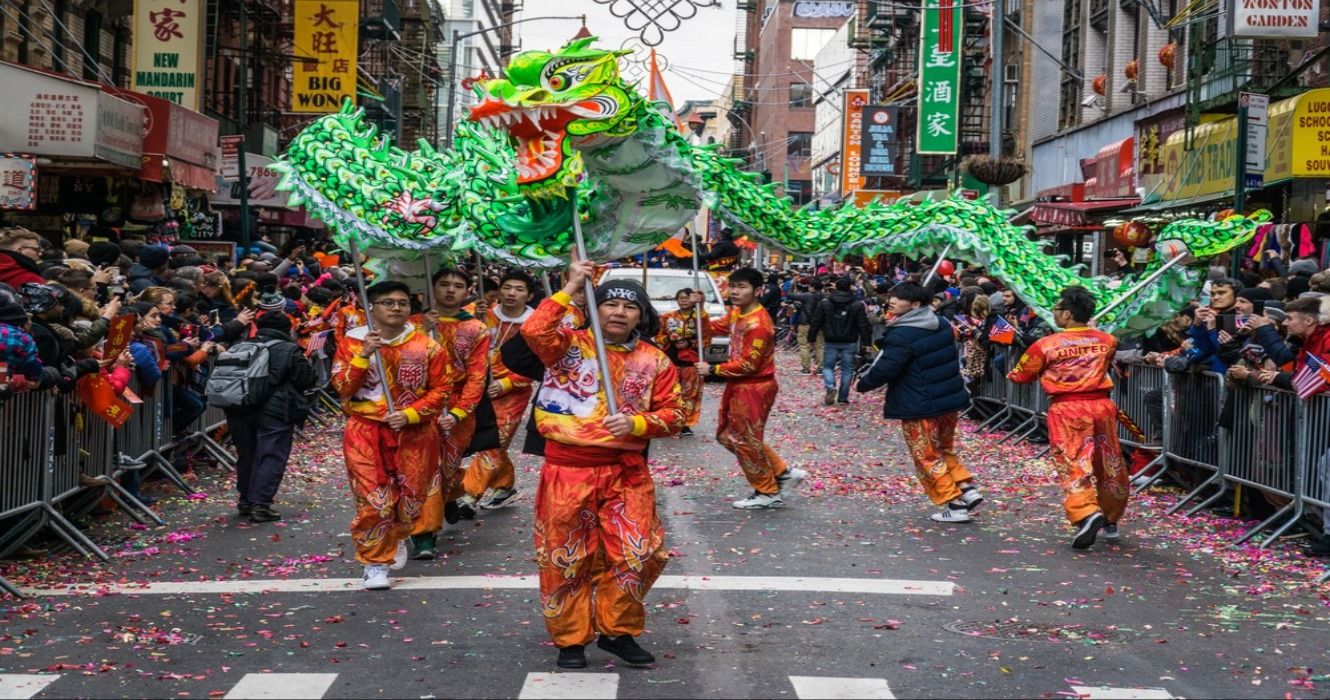Read update
- Where eye contact is considered rude
Summary
- Eye contact is interpreted differently in each culture, and it's important to be aware of the local customs before visiting a country.
- In Malaysia, prolonged eye contact is considered impolite, while in Egypt it is seen as a sign of interest and honesty.
- In China, eye contact can be seen as a challenge and a sign of disrespect, while in the United States it is highly valued as a sign of engagement in conversation.
Before travelings, one must be aware local culture, such as eating etiquette or even unspoken rules when taking selfies. Breaking cultural norms is an unavoidable part of traveling, at least to some degree. Visiting foreign places and attempting to adapt to a new way of life is bound to result in slip-ups and awkward moments. A lot of these potentially cringe-worthy situations and the ensuing guilt that often follows can be avoided. Eye contact is a powerful form of communication around the world. In fact, this study in Image and Vision computing suggests that 65% of all communication is done through eye contact, however, eye contact in different cultures can mean very different things.
However, eye contact has different meaning in each culture. In some countries, the presence of eye contact conveys confidence and instills trust in the interaction. In other countries, it is incredibly rude to look into the other person’s eyes during conversation. In general, Western cultures tend to value the presence of eye contact while Eastern ones tend to see eye contact as a form of disrespect. However, this is not always the case. For example, Australians greatly value eye contact in communication while native Australian aboriginals consider eye contact to be rude. The below entries include regional variations whenever they occur. Avoid cultural faux pas by avoiding eye contact in these places (and making sure you have it in the others!).
UPDATE: 2023/09/01 20:09 EST BY LUANA FERREIRA
Where eye contact is considered rude
Eye contact can be considered extremely rude or a sign of trust - it all depends on the culture. Travelers should be aware of cultural differences before visiting a new country, so this list has been updated to include how countries perceive eye contact.
22 Malasya (Not Recommended)
In Malaysia, avoiding prolonged eye contact is rooted in cultural and social norms. Malaysians value humility and modesty in their interactions, and extended eye contact can be interpreted as impolite or invasive, potentially making individuals uncomfortable.
Instead, Malaysians typically engage in polite, indirect glances or a lowered gaze as a sign of respect. By adhering to these customs, you acknowledge and honor the local culture, fostering harmonious and respectful connections with the people of Malaysia. It's a way of demonstrating cultural sensitivity and a willingness to adapt to local practices in social interactions.
Body language is important in Malaysia; gestures like placing the hands in the pockets or hips while talking are signs of anger.
21 Egypt (sometimes Recommended)
In Egypt, eye contact is often seen as a sign of interest, honesty and sincerity, especially when men are doing business. While people from Western countries tend to consider prolonged eye contact uncomfortable, they are common in Egypt, and they are a good sign.
However, the rule doesn't apply to the opposite gender. Egypt is a Muslim country, so males and females should lower their gazes when crossing paths. Regarding tourists traveling in Egypt, especially solo female travelers, avoiding eye contact can be an efficient way to avoid pushy street vendors.
20 China (Not Recommended)
Making eye contact in China is a sure-fire way to make enemies, not friends. The Chinese people view eye contact as a necessary tool, but not in the same way that other cultures do. In China, people make eye contact when they are angry. It is meant to challenge the other person and is a sign of disrespect. People will make direct, prolonged eye contact when they are on the defensive or if they are trying to engage in an argument. If traveling in China and someone meets your gaze, it may be time to start apologizing.
This is especially true when it comes to subordinates and supervisors. It is appropriate for someone of a higher authority to make eye contact with someone who has less, but never appropriate for someone with less authority to attempt eye contact with a person who has more.
19 Japan (Not Recommended)
As children, the Japanese are taught to focus on the neck of the other person when in conversation. This ensures that the gaze is soft and in the general direction of the other person, but does not directly meet the other’s eyes.
In Japan, it is a sign of respect NOT to make eye contact with another person. Likewise, making eye contact with another person during conversation is considered rude.The Japanese tend to keep to themselves, so making open eye contact with a random stranger is considered a violation of personal space and should be avoided. If you ever happen to visit this amazing country, just make sure to mind your own business and you will be alright!
As children, the Japanese are taught to focus on the neck of the other person when in conversation. This ensures that the gaze is soft and in the general direction of the other person, but does not directly meet the other’s eyes.
Travelers must be aware of many cultural rules when visiting Japan, including when entering the famous Japanese hot springs.
18 Iran (Sometimes Recommended)
There ar many things one should know before visiting Iran. The first of them is that in Iran, communication tends to be more indirect. According to the Cultural Atlas, conversations can extend way past what they need to in order to avoid offense and ensure that what is communicated is received in a positive way. The conversations tend to be a bit more roundabout, landing on the point well after the discussion started. Eye contact is an accompaniment to many conversations when the participants are friends or family. It conveys friendliness and openness within the conversation and is expected during these times. However, eye contact is never appropriate for the opposite gender.
Out of respect, both people are supposed to lower their gaze when communicating with a different gender. Likewise, a younger person may not make eye contact with someone older out of respect.
17 Vietnam (Not recommended)
Before discovering the top touristic attractions in Vietnam, travelers should know more about their culture.
Vietnamese people use eye contact only for very specific circumstances, and they may not be the ones you, as a traveler, are looking for. In Vietnam, eye contact is a way of showing interest in the opposite gender. Unless you want to give someone the wrong idea, be especially cautious when looking into people’s eyes of a different gender. In addition, if someone of the same gender makes eye contact, they may be looking for an argument more than a conversation.
It is best to simply avoid eye contact when visiting Vietnam to ensure there are no misunderstandings.
16 Cambodia (Not recommended)
In Cambodia, eye contact is not a normal part of most conversations. The communication is a bit softer and more indirect here, and so is the eye contact. While a person may glance up into the eyes of another when they are talking, it is not usually appropriate to sustain prolonged eye contact with someone else during a conversation. While this pertains to most conversations regardless of who is involved, it is also suggested that women look at the ground when talking with men.
The lack of eye contact in different cultures around Asia signals a show of respect for the other person.
15 Indonesia (Sometimes recommended)
In Indonesia, eye contact is a part of many conversations but not all. Like many other places on this list, eye contact should be avoided when speaking to someone older or of a higher social status. This can be tricky to figure out as a traveler. If unsure, it’s probably best to simply ask. Some Indonesians may feel uncomfortable having prolonged eye contact with Westerners, however, many people are familiar with this and are fine with it. This is a scenario where it probably makes sense to follow the lead of whoever you are speaking with. In all situations, eye contact is broken quite frequently.
14 Kenya (Sometimes recommended)
Kenya is a large and diverse country, and the cultures within it vary greatly. Considering this, it makes sense that eye contact etiquette does as well. Depending on what region of the country you are in, and what social norms there dictate, eye contact may be always necessary, sometimes used, or never included in conversations. In urban areas, it is common and expected to make eye contact with others during conversation. In other areas, eye contact is expected unless speaking with an older person or out of a sign of respect to someone in higher social standing. However, in some rural areas, no eye contact is expected during conversations.
In Kenya, try to follow what the other person is doing when you are communicating with them.
13 Hong Kong (Not Recommended)
Introductions can be especially tricky when traveling. This is another area where cultures tend to vary their greetings greatly. In Hong Kong, little to no eye contact is recommended when first greeting someone else. If meeting someone for the first time, be sure to lower your gaze when shaking their hand. If you are with someone else, wait for them to introduce you instead of introducing yourself. This changes slightly if you hold a higher position than the other person.
In this scenario, it is appropriate to hold a bit more eye contact during greetings, although it still should not be too much.
12 South Korea (Not recommended)
While there are certain situations where eye contact is acceptable when conversing with others in South Korea, they can be difficult for visitors to dissect. Similar rules apply here as they do in other places, i.e., eye contact is appropriate when speaking to people younger than you or of lower social status, however, these are not always as easy as they sound to figure out. For example, if a person is younger than you, but holds a higher position, they are technically supposed to be offered more respect and you would not make eye contact.
Play it safe here and simply avoid eye contact to ensure that you are always offering the proper respect.
11 Thailand (Make some Eye Contact, but not too much)
In Thailand, aptly named “The Land of Smiles”, nonverbal communication comes mostly from big, broad smiles painted on the faces of just about everyone you meet. The locals here are known for being friendly, warm, and welcoming to those visiting. Here, eye contact is ok when listening, and is generally used to show that you are engaged in the conversation. However, be sure to divert the eyes from time to time to ensure that the effect of the eye contact is softened a bit. Otherwise, the interaction can feel too intense and may not be welcomed by the other person.
10 United States of America (Eye Contact Welcome)
In the U.S., eye contact is extremely important. It shows a commitment to the conversation, and a willingness to engage. When making an introduction to the U.S., it is especially important. However, it must be done correctly. Eye contact is important in the initial introductions or beginning stages of a conversation, however, prolonged, uninterrupted eye contact can feel intrusive or be misconstrued.
Strike the right balance by making eye contact with the other person initially, dropping the gaze, and then revisiting it from time to time throughout the interaction.
9 United Kingdom (Eye Contact Welcome)
While it is ok to divert your eyes from time to time, eye contact is expected to remain fairly constant in all communication in the United Kingdom. When speaking to someone in the U.K., it is always appropriate, and highly recommended to make eye contact. This can be especially important when speaking to authority figures, such as a policeman. No eye contact in this scenario can suggest a shiftiness or create a lack of trust, they may even think you are lying if you avoid eye contact.
If it feels challenging to maintain eye contact throughout the entire conversation, try to at least meet the other person’s eyes some of the time.
8 Australia (Make eye contact, but not too much)
For most of Australia, eye contact during communication is used to convey sincerity and trust when speaking to one another. It is common in most situations to maintain some eye contact throughout a conversation. However, eye contact can be overdone here, there is definitely more of a balance to it. Eye contact that is maintained for too long and with too high an intensity can be considered rude or seen as a challenge.
In addition, when speaking with Indigenous Australians, it is considered very rude to maintain direct eye contact throughout the conversation.
7 Greece (Eye Contact Welcome)
In Greece, maintaining eye contact constantly throughout a conversation shows genuine attention, honesty, and sincerity. It is a vital part of communicating. On the contrary, breaking eye contact or avoiding it altogether can create unease and distrust when communicating. The Greeks are open communicators, mostly, speaking loudly often and with intense emotional inflections. The eye contact should complement this.
Make the eye conact steady, do not break it, and keep it consistent to ensure proper communication.
6 France (Eye Contact Welcome)
When having a conversation in France, respect is shown through direct and unbroken eye contact. It is seen as an investment in the discussion, shows that you are listening and engaged, and will be reciprocated in turn by the other person. To avoid eye contact, or look elsewhere during the conversation, is considered extremely rude. If speaking to anyone in France, meet their gaze, and hold it throughout the duration of the conversation to ensure proper respect and attentiveness.
5 Fiji (Eye Contact Welcome)
Fijians tend to hold intense eye contact while they are talking. Different from many other cultures on this list, there is no need to look away frequently, but rather, it is fine to hold the gaze of the other person for the duration of the communication. Voices tend to be softer when talking in Fiji, and as such, eye contact is an important part of communicating with each other.
When speaking to someone else, meet their eyes and do not look away until the conversation is over.
4 Spain (Eye Contact Welcome)
Mostly, eye contact is desired and welcomed in Spain. It is an expected part of the communication to meet or return the other person’s gaze and maintain it throughout the conversation. This rule changes slightly when it comes to conversations between different genders. As a woman, try and cautiously return a man’s gaze. It can be misinterpreted as flirting or showing an interest in him. This is not necessarily true in the reverse, however.
As a man, it is usually safe to return a woman’s gaze without implying a romantic interest in her. Eye contact is almost always recommended in Spain.
3 Canada (Make eye contact, but not too much)
In Canada, eye contact is expected during the initial greeting, both when meeting someone for the first time and when seeing someone you know. All communications should include eye contact, but breaks are important. There is no need to hold the other person’s gaze throughout the conversation. It is best to hold eye contact during introductions. As the conversation continues, continue to alternate between meeting the other person’s gaze and looking away.




















